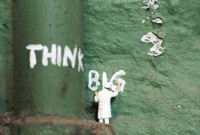- Home
- Business Processes
- Industry Knowledge
- Aerospace Industry
- Automotive Industry
- Banking Domain
- BFSI Industry
- Consumer/ FMCG Industry
- Chemicals Industry
- Engineering & Construction
- Energy Industry
- Education Domain
- Finance Domain
- Hospitality Domain
- Healthcare Industry
- Insurance Domain
- Retail Industry
- Travel and Tourism Domain
- Telecom Industry
- Leadership Skills
- eLearning
- Home
- Leadership Skills
- Creativity Tools
- Understanding Concept of Creativity
Understanding Concept of Creativity
Part of your job as a manager is to foster new ideas. But how do you assemble a team with the right mix of skills and perspectives to promote creativity? Creativity is the ability to come up with new and different ideas or breakthrough fixed ways of thinking. Learn how to manage an intellectually diverse work group and their environment to produce more and better ideas that encourage innovation when developing products and work processes.
Just what are creativity and innovation? Generally, you know them when you see them, right? But a deeper understanding of what creativity is can help you enhance the creativity of any group you lead. Let's start with a couple of definitions, and then move on to correct the most common misconceptions people have about creativity.
Meaning of Creativity
Some Useful Definitions of Creativity
Creativity is the heart of entrepreneurship while innovation is the oxygen that is keeping it alive.
'One's destination is never a place, but a new way of seeing things.'- Henry Miller
“Every child is an artist. The problem is how to remain an artist once he grows up.” - Pablo Picasso
Creativity is goal-directed thinking which is unusual, novel, and useful.
Creativity is the ability to produce work that is both novel (i.e. original, unexpected) and appropriate (i.e. useful concerning task constraints).
Creativity is involving the creation of something new and useful and creative thinking did not essentially require tangible creative products; rather the process should be more focused on defining creativity. - Runco (2007)
Creativity is just the extraordinary result of ordinary processes. - Smith, Ward & Finke
Creativity is a novel and personally meaningful interpretation of experiences, actions, and events. However, the novelty and meaningfulness of these interpretations need not require to be original or (even meaningful) to others. Indeed, the judgment of novelty and meaningfulness that constitutes creativity is an intrapersonal judgment. This intrapersonal judgment is what distinguishes creativity from other forms of creative expression. - Beghetto and Kaufman
Although we can accept its existence and importance, it has been a highly difficult task for the researchers to define creativity. Creativity refers to a person's ability to think differently or novel, which means the originality of ideas and usefulness of the ideas to the business and organization.
Can Creativity be learned?
We all are born with raw creativity ability but only a handful of few are more creative than many. Creativity is like raw material for the new and best solution for problems arising in every sphere of life. Creativity is a process of developing and expressing novel ideas that are likely to be useful. Creativity is not so much a talent as it is a goal-oriented process. Creativity begins with a foundation of knowledge, learning discipline, and mastering a novel way of thinking which comes from/by experimenting, exploring, questioning, assumptions, using imagination, and synthesizing information.
Creativity does not merely mean only "think different" and you cannot make your group more innovative just by deploying a few people who have creative character traits, and then relying on these folks for all your breakthrough ideas. It's a matter of designing a collaborative approach that maximizes everyone's distinctive gifts, experience, and expertise. Creativity is learned through practice and the development of long-term creative potential depends on experience. Therefore, since creativity also stems from experiences, it is a trait that can be acquired. Creativity is concerned more with possible solutions to a problem. The purpose or goal of the creative process is the solving of a particular problem or the satisfying of a specific need.
Dimensions of Creativity:
Novelty & Usefulness
Creativity involves thinking that aims at producing ideas or products that are relatively novel and that are in some respect, compelling. A human being is exceptionally blessed with the higher-level thinking abilities of creativity and problem-solving. Such activities require the use of already stored information along with the information concurrently received from the environment. The most advanced thought process, creativity, involves the production of uncommon and novel ideas that are highly relevant to the situation.
Creativity is not Intelligence
Creativity is defined as something different from intelligence and as a parallel construct to intelligence, but it differs from intelligence in that it is not restricted to cognitive or intellectual functioning or behavior. Instead, it is concerned with a complex mix of motivational conditions, personality factors, environmental conditions, chance factors, and even products. Creativity has some domain-specific and domain-general elements in the sense that it needs some specific knowledge, but there are certain elements of creativity that cut across different domains.
Creativity involves Convergent as well as Divergent Thinking
The creative process begins with divergent thinking where the group moves away from familiar or established ways of seeing and doing things and this in turn produces novel ideas. Convergent thinking occurs in the later stages of the creative process. As the original ideas generated by the divergent thinking are communicated to others, they are evaluated to determine which ideas are genuinely novel and worth pursuing. The group then uses convergent thinking to choose an option with the potential to solve the problem that initiated the creative process.
Creativity is about Problem Solving
Innovation is the embodiment, combination, and/or synthesis of knowledge in original, relevant, valued new products, processes, or services. Innovation is the end result of the creative process. Again, creativity is a process you employ to improve your problem-solving. So you're not done until your creative efforts have produced a product, service, or process that answers the original need or solves the problem you identified at the outset.
Characteristics of Creativity:
The process of creativity is thought to have the following four characteristics:
- Rejection of Previously Accepted Ideas
- Result of Motivation & Persistence
- Results from organizing the unclear situation in a coherent, clear, and new way.
- Creativity is measurable, at least to some extent.
- Creativity can be developed and promoted.
- Creativity is not highly rewarded in practice, as it is supposed to be in theory
- It is imaginative involving imagination since it is the process of generating something original
- It is purposeful, that is, creativity is imagination put into action towards an end.
- It produces something original in relation to one's own previous work, to their peer group, or to anyone's previous output in a particular field.
- It has value with respect to the objective it was applied for. Creativity involves not only the generation of ideas, but also evaluation of them, and deciding which one is the most adequate one.
- There are two types of creativity little or everyday creativity and Big or eminent creativity. The two forms of creativity rely on interpersonal and historical judgments of novelty, appropriateness, and lasting impact.
Related Links
You May Also Like
-
Collaborative leadership is all about collaborative problem-solving and decision-making or can also be defined as the leadership of a collaborative effort. . The term started to appear in the mid-1990s in response to the formation of long term public-private partnerships to rebuild public infrastructure. Learn how you can use principles of collaborative leadership to enhance your leadership skills for being an effective leader.
-
Evidence of the medically damaging symptoms of work stress necessitates applying the treatment of stress management. Stress management is increasingly drawing the attention to the management experts not only as a remedial measure but also as a way to resource management. If the workplace can be made a little more lovable the increase in the achievement of the organization may be much time more. If group stress can be removed by introducing group discussions and recreational facilities a long-lasting team spirit may get developed.
-
Understanding Concept of Creativity
Part of your job as a manager is to foster new ideas. But how do you assemble a team with the right mix of skills and perspectives to promote creativity? Creativity is the ability to come up with new and different ideas or breakthrough fixed ways of thinking. Learn how to manage an intellectually diverse work group and their environment to produce more and better ideas that encourage innovation when developing products and work processes.
-
Creating Highly Effective Teams
How do we create effective teams? What comes to mind when you think about an effective team? High performing teams exhibit accountability, purpose, cohesiveness, and collaboration. It is a team that works seamlessly as a whole. Everyone brings unique talents and strengths and support each other to bring out the best in everyone. How do you create one?
-
In today's innovation-driven economy, understanding how to generate great ideas has become an urgent managerial priority. Managers need to encourage and champion ideas and need to help their organizations incorporate diverse perspectives, which spur creative insights and facilitate creative collaboration by harnessing new technologies. Innovation is the embodiment, combination, and/or synthesis of knowledge in original, relevant, valued new products, processes, or services.
-
We define Lean as the systematic elimination of waste through a continual effort to decrease inefficiency; the lean leader strives to create a more efficient organization. Lean leadership is a philosophy. It is a consistent way of thinking and being in your role as a leader. The focus of this approach is on raising new leaders and help their team embrace a culture of continuous improvement. Learn what we mean by lean leadership style and its principles.
-
Change & Culture of Innovation
Predicting the future is a tricky business but managers need to have a future perspective in order to take business advantage and remain competitive. They need to drive and introduce constructive change to the business of the enterprise. The first step to creativity and innovation is to drive a culture of Innovation. Managers need to focus on developing future mindset all the time to keep pace with the unfolding future.
-
Understanding Corporate Strategy
Management outlook and procedures have been revolutionized by more and more innovations over the recent years. It is no longer possible to follow traditional approaches to develop your organization's direction, its management as well its effectiveness. Senior managers need to be good decision-makers. In this section, we introduce concepts for strategy, strategic planning, strategic leadership, their exact meaning and associated terms, and how to use them.
-
Generating Ideas using SCAMPER
SCAMPER is an activity-based thinking process that can be performed by Cooperative learning. SCAMPER is an acronym that provides a structured way of assisting students to think out of the box and enhance their knowledge. This can be used in the organizational context as a technique for creative problem solving and as a toolkit to generate fresh ideas.
-
In its simplest sense, decision-making is the act of choosing between two or more courses of action. Decision making is a key skill in the workplace and is particularly important if you want to be an effective leader. When decisions have to be made, there are several stages that you should go through to reach a practical solution. Understand the meaning and importance of decision making and how to look at it as a process.
Explore Our Free Training Articles or
Sign Up to Start With Our eLearning Courses

About Us
Learning
© 2023 TechnoFunc, All Rights Reserved










